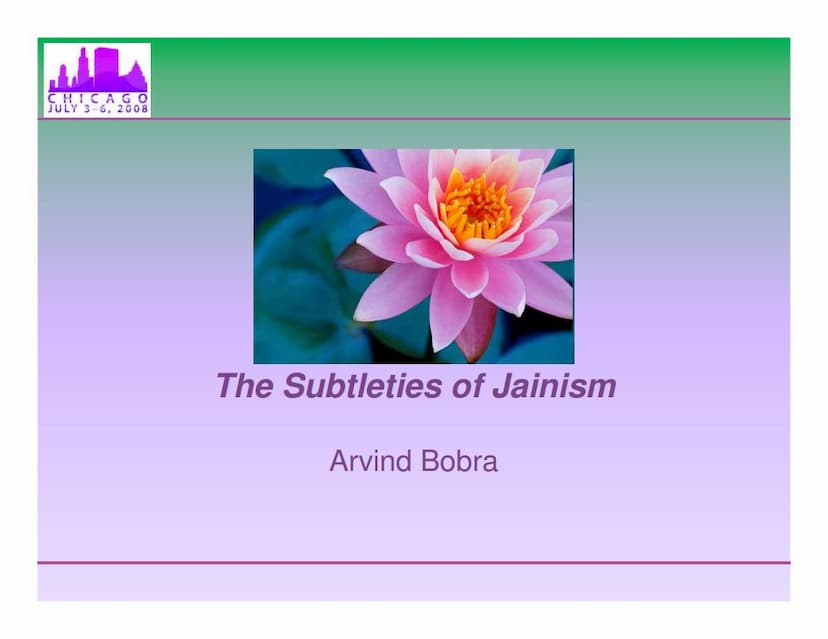Subtleties Of Jainism
Added to library: September 2, 2025

Summary
Here's a comprehensive summary of Arvind Bobra's "Subtleties of Jainism," based on the provided text:
Overview and Core Principles:
The presentation "Subtleties of Jainism" by Arvind Bobra aims to be thought-provoking, encouraging reflection on subtle actions and their connection to the Jain principle of the continual inflow of karma. Every moment, thought, intention, breath, and movement contributes to the accumulation of wholesome or unwholesome karma, influenced heavily by one's mental attitude. The quantity, duration, and intensity of karma are determined by the emotional engagement at the time of its binding.
Emotional Engagement and Kashaya:
Jainism identifies four primary negative passions (Kashaya) that fuel unwholesome karma: anger, ego/pride, deceit, and greed. The ultimate goal is to reduce these passions and shift from generating unwholesome to wholesome karma.
The Subtle Path to Change:
Bobra emphasizes that significant change cannot be achieved through mere decisions alone. Instead, it stems from making subtle, small changes in daily actions. These seemingly minor adjustments create a ripple effect, leading to larger, more significant transformations. This is an evolving process, a subtle journey that begins with the "little things." There isn't a single prescriptive answer; understanding and personal resonance are key.
Examples of Subtle Practices:
The presentation delves into various everyday activities and their potential to generate karma, highlighting areas where subtle choices can be made:
- Morning Routine: Activities like brushing teeth, showering, shaving, applying makeup, and getting dressed are presented as opportunities to be mindful of the karma generated.
- Personal Care Products (Soaps, etc.): Bobra questions the use of products that are not explicitly vegetarian or vegan, suggesting that if one wouldn't eat or touch an ingredient, it's questionable for cleansing the body.
- Non-Veg Products & By-products: The text argues that products derived from non-vegetarian sources carry "negative energy," "impurity," and "violence." It highlights the "high unnatural secretions of hormones" associated with such products and the violence involved in their creation. The long lists of chemical ingredients (Slides 11-17) serve to illustrate the complexity and often hidden animal-derived components in everyday products, suggesting that it's "just no way to know" the full extent of potential harm without careful investigation.
- Leather: Monks' avoidance of leather is cited as an example of its perceived impurity and connection to violence. The presentation encourages seeking ethical alternatives.
- Silk: The production of silk is described as involving the boiling or heating of silkworms alive, with a significant number of worms needed for a small amount of cloth. This is presented as a point of ethical consideration for consumers.
- Alcohol: Alcohol is seen as a major impediment to the spiritual journey. It is believed to increase the intensity of passions (Kashaya) and lower inhibitions, making individuals more susceptible to committing the five cardinal sins: violence, lying, stealing, lewd behavior, and possessiveness.
- Honey: The consumption of honey is discouraged due to the implied death of bees, larvae, pupae, and their eggs in the process, as well as the nature of the substance itself (regurgitated material).
- Egg Farming: The presentation includes several slides illustrating the practices of egg farming, implying that eggs are not considered vegetarian in Jainism and are treated as meat. They are also noted to contain animal stem cells and be a "menstrual cycle byproduct."
Positive Practices for Spiritual Growth:
- Namokar Mantra: Daily recitation of the Namokar Mantra is recommended for bringing stability and calmness.
- Simple Rules: Creating personal rules helps gain control over one's mind and actions, contributing to self-mastery and spiritual progress.
- Service: Engaging in acts of service cultivates compassion, decreases passions, and creates a positive "ripple effect." Even a simple smile can be an act of service.
Putting It All Together:
The presentation concludes by suggesting that the strength for spiritual progress comes from integrating these subtle practices across various aspects of life: the Namokar Mantra, cleansing habits, clothing choices, eating patterns, electricity consumption, and service to others.
Conclusion:
The core message is that these examples are for reflection, encouraging individuals to identify what resonates with them. The overarching principle of Jainism is that "All life is bound together by mutual support and interdependence," and "Ahimsa is the supreme dharma!" (non-violence is the highest duty).